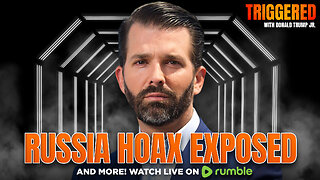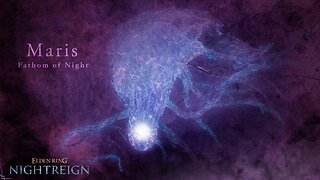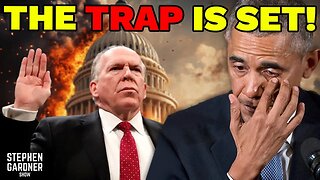Premium Only Content

James Smithson, Smithsonian Institute & Occult Numbers In Entertainment
Cause Before Symptom With Your Host James Carner
James Smithson, Smithsonian Institute & Occult Numbers In Entertainment
Smithson, who founded the Smithsonian Institution, was born in 1765 to Elizabeth Keate Hungerford Macie and was the illegitimate son of Hugh Smithson, who later became the Duke of Northumberland. James Smithson’s mother was descended from Henry VII of England, but James was one of a reported four children conceived out of wedlock by his father, according to Smithson biographer Heather Ewing. He and his siblings were never recognized by the Duke of Northumberland, and the descendants had long struggled to place themselves within the larger family.
He was the illegitimate son of Hugh Smithson, the first Duke of Northumberland, and a wealthy widow named Elizabeth Hungerford Keate Macie. While his exact inheritance details are somewhat unclear, it's generally accepted that he received a substantial sum from his mother's estate.
It's important to note that Smithson was a complex figure, and his decision to leave his entire fortune to establish the Smithsonian Institution in the United States is a fascinating story in itself. James Smithson's wealth was estimated to be around £100,000 This was a substantial sum in the early 19th century. When converted to US dollars and brought to America, the money amounted to approximately $508,318.46. It's important to remember that this was a massive amount of money at that time, representing about 1/66 of the entire US federal budget.
James Smithson's decision to leave his entire fortune to establish the Smithsonian Institution in the United States is one of the most intriguing stories in philanthropic history.
1. James Smithson - Philanthropy Roundtable
www.philanthropyroundtable.org
While the exact motivations behind his decision remain a mystery as he never visited America, several theories have been proposed:
* A love of science: Smithson was a renowned chemist and mineralogist. He likely saw the United States as a young, dynamic nation with a thirst for knowledge.
* A desire for legacy: By establishing an institution dedicated to the "increase and diffusion of knowledge among men," Smithson sought to create a lasting impact on the world.
* A political statement: Some speculate that Smithson may have been making a political statement about the potential of a democratic society to foster intellectual growth.
It's important to note that Smithson’s decision was met with skepticism and controversy at the time. Many questioned the wisdom of accepting money from a foreigner. However, the eventual establishment of the Smithsonian Institution has proven to be a cornerstone of American culture and education.
James Smithson's bequest was used to establish the Smithsonian Institution.
His explicit instructions were to create "an establishment for the increase and diffusion of knowledge among men." With that mandate, the Smithsonian has grown into a vast network of museums, research centers, and educational programs.
Here's a brief overview of how the funds were used:
The initial funds were used to construct the original Smithsonian building (often called the "Castle") and establish the institution's infrastructure. Research and Exploration: A significant portion of the endowment has supported scientific research and exploration, from early expeditions to the depths of space. Museum Collections: The funds have been instrumental in acquiring and preserving vast collections of art, history, and natural science specimens. Public Education: The Smithsonian has used its resources to create engaging exhibits, educational programs, and online resources for people of all ages. Essentially, Smithson's legacy has been transformed into a public trust dedicated to the advancement of knowledge and the enrichment of society.
James Smithson was a British chemist and mineralogist. He published numerous scientific papers for the Royal Society during the early 1800s as well as defining calamine, which would eventually be renamed after him as "smithsonite". He was the founding donor of the Smithsonian Institution, which also bears his name. Born in Paris, France, as the illegitimate child of Elizabeth Hungerford Keate Macie and Hugh Percy (born Hugh Smithson), the 1st Duke of Northumberland, he was given the French name Jacques-Louis Macie. His birth date was not recorded and the exact location of his birth is unknown; it is possibly in the Pentemont Abbey. Shortly after his birth he naturalized to Britain where his name was anglicized to James Louis Macie. He adopted his father's original surname of Smithson in 1800, following his mother's death. He attended university at Pembroke College, Oxford in 1782, eventually graduating with a Master of Arts in 1786. As a student he participated in a geological expedition to Scotland and studied chemistry and mineralogy. Highly regarded for his blowpipe analysis and his ability to work in miniature, Smithson spent much of his life traveling extensively throughout Europe; he published some 27 papers in his life.
Smithson never married and had no children; therefore, when he wrote his will, he left his estate to his nephew, or his nephew's family if his nephew died before Smithson. If his nephew were to die without heirs, however, Smithson's will stipulated that his estate be used "to found in Washington, under the name of the Smithsonian Institution, an establishment for the increase and diffusion of knowledge among men". He died in Genoa, Italy, on 27 June 1829, aged 64. Six years later, in 1835, his nephew died without heir, setting in motion the bequest to the United States. In this way Smithson became the patron of the Smithsonian Institution in Washington, D.C., despite having never visited the United States.
There have been any number of guesses about this, because Smithson didn't leave us with any clear answers. According to one Smithsonian historian and conservator, William Bennett, Smithson was angry at the legal battles associated with his mother's estate and the way he had been treated by the upper classes of British society, and wanted to get his money out of the country while still ensuring his own legacy.
Heather Ewing, who consulted with the Smithsonian on the online exhibition From Smithson to Smithsonian, thinks that the donation came from the contemporary interest in a "culture of improvement," and says that Smithson believed the United States was going to be a great artistic and scientific leader in the future and wanted to support that (she ties in a dislike for British aristocracy as well, and the new nation would do better in that regard, etc).
Nina Burleigh's book "The Stranger and the Statesman" is probably the best known on the subject, but she doesn't actually come up with any answers. It's excellent reading, particularly regarding the discussions in Congress over whether to accept Smithson's money, but it waffles between "he wanted to leave a legacy" and "he wanted to increase human knowledge" - which, well, yes, he said he was for the increase and diffusion of knowledge, and does anyone leave money for a museum without wanting to leave a legacy? So it's a good book but no answers.
Again, though - we don't really know. Bennett has done the most recent digging on it, he's done extensive archival research, but the smoking gun of "why" still hasn't turned up. (As for why Washington rather than New York, I don't think we have an answer to that either - we only even have speculation about why the US rather than the UK.)
The closest we can come to an understanding of James Smithson and how he received his wealth and knowledge. Conservator William Bennett shares highlights from his August 2022 visit to the United Kingdom, where he visited four archival repositories, viewed and studied 54 different documents, and spoke with three local experts in his quest to better understand the Hungerford Deed and James Smithson’s milieu.
Readers of The Bigger Picture will be familiar with the Hungerford Deed, a 1787 property contract dividing a lucrative land inheritance between the mother and aunt of the Smithsonian’s founding donor, James Smithson. Over the last three years I have been able to take a deep dive into the content of the Deed and strengthen our understanding of Smithson’s choice to leave his wealth to the United States and form the Institution—and have shared many of those findings here and in the online exhibit A Tale of Two Sisters. But many questions still remain.
William Bennett said, “Last month, I had the opportunity to travel to the United Kingdom to try and begin answering some of these questions. I visited four archival repositories, viewed and studied 54 different documents, and spoke with three local experts in my quest to better understand the Deed and James Smithson’s milieu (logging 140,776 steps over 68.03 miles!). Highlights include seeing the following:
Smithson’s naturalization document. James Smithson was born in Paris and had to be naturalized a British citizen at the age of nine. At the time, this required a private act in the British Parliament, so I visited their archives to see this document, which places limitations on his citizenship despite claiming his rights and privileges would be the same as other citizens.
[He recorded] The National Archives hold the voluminous legal records of Chancery, where Macie v Walker was decided in 1787, along with wills and other Hungerford family lawsuits.
[He recorded] Macie v Walker. The Hungerford Deed recounts Smithson’s mother, Elizabeth Macie, suing her sister, Henrietta Maria Walker, to enforce the partition of Hungerford lands. It was thrilling to see the paperwork from Macie’s lawsuit and read in her own words her accusations against her sister, as well as see her seal and signature.
[He recorded] The legal firm that helped authenticate Smithson's will was housed here in Lincoln's Inn from at least the 1820s until the 1970s. Image courtesy of William Bennett.
[He recorded] US President vs Charles Drummond. To secure Smithson’s bequest, American diplomat Richard Rush was dispatched to the United Kingdom, where he launched his own suit to obtain the funds. Drummond was Smithson’s executor and raised some questions about whether Smithson could bequeath money out of the country, and this battle is captured in the legal documents.
[He recorded] Studley House. This property was coveted by Walker and she obtained it in the partition. I was able to visit during my travels and see it firsthand. Studley is one of the properties we know the most about due to a well-documented history of ownership. The current house was built during Smithson’s lifetime but was not the original home Walker received in the partition.
[He recorded] Cadenham Manor. While this home was not included in the Hungerford Deed (it had already passed out of the family’s hands), the house was built by Macie and Walker’s great-grandfather, Sir George Hungerford. His conflict with his second son, Walter, is reminiscent of the family disagreements between Macie and Walker, and his aspirations to grandeur reflected in his home recall Macie and Walker’s pursuit of their Hungerford legacy.
Much remains to be done with my research before our questions will all be answered, and there are still gaps in our knowledge, but this was an important first step.
The Smithsonian Institution has been the subject of various conspiracy theories alleging the suppression of historical truths. While these claims are often sensationalized and lack substantial evidence, they've gained traction in certain circles.
Common Accusations
Suppression of Giant Human Remains: One of the most persistent claims is that the Smithsonian has hidden evidence of giant human skeletons found in North America. This theory often cites the Lovelock Cave findings in Nevada. However, mainstream archaeology has explained these remains as belonging to individuals with pathological conditions rather than a lost race of giants.
Cover-up of Advanced Ancient Civilizations: Some believe the Smithsonian has concealed evidence of highly advanced ancient civilizations, such as the ability to build structures like the pyramids without modern technology. These claims often involve alternative theories and interpretations of archaeological data.
Withholding Information About UFOs and Extraterrestrial Life: While not exclusively tied to the Smithsonian, some conspiracy theories suggest the institution is part of a broader government cover-up regarding extraterrestrial activity.
Richard J. Dewhurst's "The Ancient Giants Who Ruled America" presents a controversial theory that North America was once inhabited by a race of giants whose existence has been systematically concealed by the Smithsonian Institution.
The book's central arguments include:
Existence of Giants: Dewhurst claims that numerous giant skeletons have been discovered across the United States, with particular concentration in the Mississippi Valley.
Smithsonian Cover-up: He alleges that the Smithsonian has been actively suppressing evidence of these giant remains for over a century, starting with John Wesley Powell's directorship.
Advanced Civilization: The book suggests that these giants possessed a sophisticated civilization, capable of constructing monumental structures.
To support his claims, Dewhurst cites historical newspaper accounts, personal testimonies, and photographs of alleged giant remains.
While the Smithsonian Institution is generally regarded as a pillar of scientific research and cultural preservation, it has faced criticism from various quarters. Here are some notable examples:
1. Archaeologists and Anthropologists with Alternative Theories
Those who support fringe theories: Some archaeologists and anthropologists who advocate for alternative explanations of human history, such as ancient astronaut theories or lost civilizations, often criticize the Smithsonian for adhering to mainstream scientific consensus.
Indigenous communities: Certain Native American groups have criticized the Smithsonian for its handling of Native American artifacts and cultural materials, alleging a lack of respect and inadequate repatriation efforts.
2. Creationist and Religious Groups
Opponents of evolution: Some creationist and religious groups have criticized the Smithsonian's support of evolutionary theory and its portrayal of human origins.
3. General Public
Individuals with personal beliefs: Some members of the public may criticize the Smithsonian for its stance on specific issues, such as climate change or political correctness.
Assuming for a moment that the Smithsonian was involved in a cover-up of historical information, here are some potential motives:
1. Preserving the Status Quo:
Maintaining societal order: Radical departures from established historical narratives could potentially lead to social unrest or upheaval.
Protecting established theories: Overthrowing long-held scientific and historical paradigms can be challenging for the scientific community and institutions.
2. Financial and Institutional Interests:
Funding and prestige: The Smithsonian, like any institution, relies on funding and reputation. Admitting to past mistakes or oversights could damage its image and funding sources.
Control of narrative: By controlling the information presented to the public, an institution can maintain its authority and influence.
3. Government Pressure:
National security: In some cases, governments may pressure institutions to suppress information deemed sensitive to national security.
Political agendas: Government officials might want to control the historical narrative for political gain.
4. Personal Gain or Ambition:
Career advancement: Individuals within the institution might benefit personally from suppressing information, such as career advancement or financial rewards.
Cover-up of personal mistakes: If individuals were involved in the suppression of evidence, they might be motivated to protect their reputations.
There isn’t much more information about why James gave his entire fortune to Washington DC and what they did with it. He was a scientist and judging by his works, he could have been a darwin supporter and against religion. He could have given his entire estate away to preserve science and darwinism. They state they are a government-funded institution dedicated to the preservation, study, and dissemination of knowledge. As such, it adheres to the principle of separation of church and state. Today, rough numbers put them at a value of 5.4 billion. As to covering up giant bones to discredit history, we can only speculate what their goals are. I believe if true, the Bible in geneis 6 talks about Giants amongst the earth that were bred by fallen angels. in 1 Enoch, it goes into more detail about the giants, their destruction of the earth and the punishment for the fallen angels. In order to cover up the truth in this to continue the big bang theory that we came from nothing, the smothsonian could be devote darwinists and if the information gets out could ruin their credibility and could have significant harm to the ecnomoy and evolution. All schools teach it and those that are not religeous would have a paradigm shift.
The Numbers Game: Unveiling the Mystery of 23, 32, and 33
Why do the numbers 23, 32, and 33 seem to appear with uncanny frequency in movies? One theory suggests these digits are intentionally embedded to manipulate our subconscious. Let's delve into the possible reasons.
The Enigma of 23
The number 23 has become a cultural obsession. It's found everywhere from numerology to conspiracy theories. In numerology, 23 is linked to growth, change, and positive energy. The film "The Number 23" amplified this fascination,portraying it as a sinister force. Mathematically, 23 is a prime number, adding to its mystique.
Beyond pop culture, 23 holds significance in various religions and even our biology. Our biorhythms and blood circulation align with this number, hinting at a deeper connection. Breaking it down, 2 represents intuition and 3 symbolizes imagination. Combined, they create a powerful force for manifesting desires.
The Significance of 32 and 33
The numbers 32 and 33 carry symbolic weight in different realms. Thirty-two is prominent in Freemasonry, representing leadership and sovereignty. While 33 is deeply rooted in Christianity, associated with Jesus Christ's age at crucifixion and symbolizing completion and sacrifice.
Subconscious Manipulation or Coincidence?
The repeated exposure to these numbers might be influencing our perception. The Baader-Meinhof phenomenon suggests we notice things more once we become aware of them. However, the intentional placement of these numbers in films raises questions about potential subliminal messaging.
Ultimately, the meaning we assign to these numbers is subjective. Whether it's numerology, symbolism, or mere coincidence, the fascination with 23, 32, and 33 continues to captivate our attention.
Deeper Dive into the Number 23
We've touched on the surface of the number 23's significance. Let's delve deeper:
* Historical and Cultural References: The number 23 has shown up in various historical events, works of literature,and art. Some examples include: | Example | Description | |---|---| | There are 23 pairs of chromosomes in the human genome. | | | The film 'The Number 23' starring Jim Carrey explores the concept of 23 as a mysterious force. | | | In numerology, 23 can symbolize growth, change, and positive energy. | |
* Psychological Impact: The repeated exposure to the number 23 in various contexts may influence our perception through a cognitive bias known as the Baader-Meinhof phenomenon. Once we become aware of something, we tend to notice it more frequently. Additionally, filmmakers might intentionally use the number 23 to evoke specific emotions or themes in viewers, tapping into the collective unconscious.
* The Role of Media: Media, particularly film, has played a significant role in amplifying the fascination with the number 23. Films like 'The Number 23' and others that incorporate the number in subtle or overt ways can contribute to the perception of its prevalence.
Why are the numbers 23, 32 and 33 in all movies? Luke 23:32-33 says, Two other men, both criminals, were also led out with him to be executed. 33 When they came to the place called the Skull, they crucified him there, along with the criminals—one on his right, the other on his left. Satanists or Luciferians mock the Trinity like demons do by knocking three times. Let’s break down each number so you know why these numbers are put into your subconscious on purpose.
23 is the most common number. There are 23 pairs of chromosomes in the human genome. In numerology, the number 23 can have many meanings, including: Happiness, Growth, Personal freedom, Positive energy, and The ability to make changes. The 23 enigma is regarded as a corollary of the Law of Fives because 2 + 3 = 5. In these works, 23 is considered lucky, unlucky, sinister, strange, sacred to the goddess Eris, or sacred to the unholy gods of the Cthulhu Mythos. In Pop culture: The number 23 has also gained significance in popular culture due to the 2007 psychological thriller film "The Number 23" starring Jim Carrey. The movie explores the concept of the number 23 as a mysterious and ominous force that appears repeatedly in the protagonist's life. In Mathematics: Mathematically, 23 is a prime number, which means it is only divisible by 1 and itself. Prime numbers have special properties and are fundamental in number theory and cryptography.
In Conspiracy theories: Some conspiracy theories and urban legends have also attached significance to the number 23, such as the "23 enigma" which suggests that the number appears more frequently in daily life than would be expected by chance. Some interesting things about the number 23.
Throughout the history, number 23 was important to numerous religions including Christianity and Islam. According to Kabbalism and Hurufism, there are many ‘holy numbers’ in our life. The number 23 is one of them. It is also one of the happy number. Number twenty-three is also in our body and genes. The average human physical biorhythm is 23 days and the blood circulates the body on average every 23 seconds
23 is a powerful number if you look at it from a broken down perspective. First of all, 2 is the number of intuition, sensitivity, peace, harmony, cooperation, and support. The 3 is the optimistic number of imagination, inspiration, memory. It’s the gateway number to the mental plane and the number or frequency/vibration we utilize most in order to manifest (dream up, create) all that we desire, here on the earthly plane. Using our intuition (2) to guide our imaginative, optimistic, inspirational forces when it comes to thought and idea generation, makes for a phenomenal combo. Why? 2+3=5, so the base value of this combination is the 5, the number of the heart/emotions, symbolizing freedom of expression. It is the Expressive Artist.
The 5 links all the other base numbers in mathematics (1–9, 0) together on the numerological chart. It’s very quantum physics, mathematical, science-based rather than most people thinking it’s more about metaphysics - it’s not. It’s highly accurate as a science (hence the alternative name, the Science of Numbers). Think about the last time you regretted something? It wasn’t what you thought at the moment that you remember most. It’s how you FELT. Our emotions/heart are the built-in navigation system that will NEVER steer us wrong. Use your intuition (2) to guide you when creating your reality and all you want to appear in your reality (3). That is the Expressive Artist (5) or the Conscious Creator. This comes from Celebrity Numerologist, Michelle Arbeau.
There is significance in all numbers. More than 2,500 years ago Plato, the great Greek Philosopher said that "all is derived from number" and that "numbers are the cloak of Divinity."
The sacredness of numbers begins with the great First Cause, the ONE, and ends only with the nought or zero—symbol of the infinite and boundless circle which represents the Kosmos, or universe. All the intervening figures, in whatever combination, or however multiplied, either represent specific philosophical ideas, spiritual and material laws, or definite moral or physical facts in nature. Numbers, when rightly understood in all their manifold permutations and interrelationships, are the master-key to the mysteries of creation and evolution, both in the Kosmos, and in Man, spiritually as well as psychically and physically. Thus taught Pyathagoras, Plato, Thales, Euclid and many other great minds of the past.
If you wish to know more about numbers this article explains much about their esoteric significance.
The occult significance of the number 23 was imported from Kabbalist gematria. Many ancient cultures developed gematria systems, some more involved than others. The number 23 corresponds with the Hebrew words for life and joy. Crowley took this and defined 23 as meaning "the joy of dissolution," by which I am guessing he meant "transcendence." Because Austin Osman Spare referred to he Zos Kia (life -joy) and also because the number 23 was spoofed in the book The Illuminatus! Triology, 23 is the signature number of Chaotes in a way similar to how 93 is important to Thelemites.
The number 32 represents the 32nd degree in Scottish Freemasonry. 32nd Degree: In the Scottish Rite of Freemasonry, the 32nd degree is a high-ranking degree, often associated with leadership and sovereignty. Numerical Significance: The number 32 could be interpreted numerically as representing completion or fulfillment, as it's the product of 4 (often symbolizing the material world) and 8 (often symbolizing spirituality). However, this interpretation is speculative and not universally accepted. Hebrew Gematria: While there's no specific, widely recognized meaning for 23 in Hebrew gematria, it could be broken down into its components: 2 and 3. 2 often symbolizes duality, partnership, or balance. 3 represents trinity, completion, or spiritual growth. Other Systems: In other gematria systems, the meaning of 23 would depend on the specific alphabet and assigned values. Hebrew Gematria: The Hebrew word for "heart" (לב) has a numerical value of 32. This might suggest a connection to inner life, emotions, or love. Other Systems: As with 23, the meaning of 32 would vary based on the gematria system.
The number 33 holds more significant symbolism in Freemasonry:
33rd Degree: This is the highest degree attainable in the Scottish Rite, often considered to be honorary. It's associated with wisdom, perfection, and divine connection. Christological Connection: In Christian tradition, Jesus is often believed to have lived for 33 years. While Freemasonry is not a religion, it incorporates symbolism from various faiths, and the number 33 can be seen as a reference to this Christian symbolism. Hebrew and Christian Gematria: The number 33 is often associated with Jesus Christ, as it's believed to be the age at which he died. It symbolizes completion, sacrifice, and divine perfection. Other Systems: The meaning of 33 in other gematria systems would depend on the specific values assigned to letters.
Could all of this be The Baader-Meinhof Phenomenon also known as frequency illusion, Where the cognitive bias in which a person notices a specific concept, word, or product more frequently after recently becoming aware of it? Or is it Personal Significance where the creators of the movies are placing these numbers in for reasons we may not know.
Why do the numbers 23, 32, and 33 seem to appear with uncanny frequency in movies? One theory suggests these digits are intentionally embedded to manipulate our subconscious. Let's delve into the possible reasons.
The Enigma of 23
The number 23 has become a cultural obsession. It's found everywhere from numerology to conspiracy theories. In numerology, 23 is linked to growth, change, and positive energy. The film "The Number 23" amplified this fascination, portraying it as a sinister force. Mathematically, 23 is a prime number, adding to its mystique.
Beyond pop culture, 23 holds significance in various religions and even our biology. Our biorhythms and blood circulation align with this number, hinting at a deeper connection. Breaking it down, 2 represents intuition and 3 symbolizes imagination. Combined, they create a powerful force for manifesting desires.
The Significance of 32 and 33
The numbers 32 and 33 carry symbolic weight in different realms. Thirty-two is prominent in Freemasonry, representing leadership and sovereignty. While 33 is deeply rooted in Christianity, associated with Jesus Christ's age at crucifixion and symbolizing completion and sacrifice.
Subconscious Manipulation or Coincidence?
The repeated exposure to these numbers might be influencing our perception. The Baader-Meinhof phenomenon suggests we notice things more once we become aware of them. However, the intentional placement of these numbers in films raises questions about potential subliminal messaging.
Ultimately, the meaning we assign to these numbers is subjective. Whether it's numerology, symbolism, or mere coincidence, the fascination with 23, 32, and 33 continues to captivate our attention.
We've touched on the surface of the number 23's significance. Let's delve deeper.
The 23 Enigma: This concept, popularized by Robert Anton Wilson, suggests the number's pervasive influence in various aspects of life. From historical events to personal experiences, proponents of the 23 enigma believe it holds hidden patterns.
Psychological Impact: The number 23's frequent appearance in film could be a deliberate attempt to tap into collective unconsciousness. By associating the number with specific emotions or themes, filmmakers can manipulate audience reactions.
The Masonic and Christian Significance of 32 and 33
We've established the Masonic and Christian connotations of 32 and 33 respectively. Let's expand on these:
Masonic Symbolism: Delve into the specific rituals and teachings associated with the 32nd degree. How might these symbols and concepts be subtly incorporated into film narratives?
Christian Iconography: Explore the various representations of the number 33 in Christian art and literature. How might these images or stories influence filmmakers?
Comparative Analysis: Compare and contrast the symbolism of 32 and 33. Are there any overlapping meanings or potential connections between the two numbers?
Exploring Other Numerical Patterns in Film
Beyond 23, 32, and 33, other numbers might hold significance in film:
Seven: A commonly recurring number in storytelling, often associated with completion or perfection.
Thirteen: Often associated with bad luck or misfortune, how is it used in film to create suspense or tension?
Number Sequences: Explore patterns of numbers appearing together in films, such as date combinations or specific sequences of digits.
Ultimately, the pervasive nature of these numbers in our cultural landscape raises intriguing questions about the human mind and its susceptibility to patterns. Whether these numerical occurrences are products of chance, subconscious manipulation, or a combination of both, they continue to captivate and baffle us, serving as a testament to the enduring mystery of numbers and their influence on our lives. If there is an occult message being used to control a narrative, the secret is well hidden. We can only specualte and come to assumptions but so far there is no concrete evidence supporting a nefarious objective.
Sources
Mr. Smithson’s Family Goes to Washington | Smithsonian
https://www.quora.com/What-is-the-importance-of-number-23
Is there any significance in the number 23? : r/occult
* A Tale of Two Sisters: The Hungerford Deed and James Smithson's Legacy (online exhibition curated by William Bennett)
* The Lost World of James Smithson: Science, Revolution, and the Birth of the Smithsonian by Heather Ewing
* The Stranger and the Statesman: James Smithson, John Quincy Adams, and the Making of America’s Greatest Museum: The Smithsonian by Nina Burleigh
https://siarchives.si.edu/blog/walking-footsteps-hungerfords
-
 56:41
56:41
Donald Trump Jr.
10 hours agoLies, Leaks, and Lawfare: Censorship Corruption Exposed | TRIGGERED Ep.263
165K132 -
 1:19:46
1:19:46
Precision Rifle Network
7 hours agoS4E25 Guns & Grub - Rex Is Back, I shot the 6.5PRC finally...
25.1K1 -
 LIVE
LIVE
rhywyn
4 hours agoうつ
46 watching -
 LIVE
LIVE
RyuMuramasa✧
6 hours agoNEW Everdark Sovereign | Elden Ring Nightreign | LIVE Playthrough
35 watching -
 1:17:04
1:17:04
Nikko Ortiz
14 hours agoLive - News, Politics, Podcast And Naaah Im Playin We Chillen
10.1K -
 1:26:13
1:26:13
Mally_Mouse
8 hours agoLet's Hang!! -- P.O. Box & Chill!
22.2K -
 1:02:37
1:02:37
BonginoReport
9 hours agoKamala Teases Book About Dumpster Fire Campaign - Nightly Scroll w/ Hayley Caronia (Ep.102)
77.4K62 -
 35:05
35:05
Stephen Gardner
9 hours ago🔥Obama will be FORCED to Testify in Trump trial?
36.6K78 -
 9:08
9:08
Tundra Tactical
6 hours ago $1.23 earnedTundra Tactical Political Memes Review!
26K2 -
 4:54:44
4:54:44
GloryJean
7 hours agoDuos w/ Spartakus 🔥 LOCK IN for Games w/ PASSION
12.4K